|
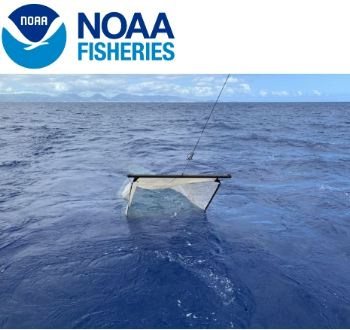
Tucker trawl in the water just after deployment. Credit: NOAA Fisheries/Johanna Wren
NOAA: Net-working in the Pacific
 UNITED STATES
UNITED STATES
Friday, July 12, 2024, 06:40 (GMT + 9)
A team of scientists recently collected marine organisms with large nets to help better understand the biological composition of our ocean. Learn about these tools that help our scientists net-work all around the ocean.
Using net tows to sample the ocean is one of the oldest methods for collecting marine organisms and one of the most vital tools for open ocean research. During a fisheries oceanography research mission, we often deploy multiple types of nets. Each has different features and captures a different range of organisms that supports tuna, pelagic predators, and protected species like whales. The combined catch provides us with a more complete representation of the ecosystem that we are trying to better understand. During the recent Bigeye Tuna Oceanography research mission, our team used three types of nets to collect the samples: bongo plankton net, Isaacs-Kidd midwater trawl, and Tucker trawl.
Bongo Plankton Net
The bongo plankton net consists of two large, attached metal rings (70 centimeters in diameter). Each ring is fitted with its own net made of 200 micrometers mesh (0.02 centimeters). Bongo nets are towed throughout the water using 300 meters of wire. They are deployed at a 45 degree angle for the net to reach a target depth of 210 meters. To help the net reach that depth, a lead weight weighing around 100 pounds is attached to the net frame. As with all of the nets, preparation includes ensuring that its many parts are secured for use. The net’s shackles, swivels, and metal rings are carefully set up and thoroughly examined before use.
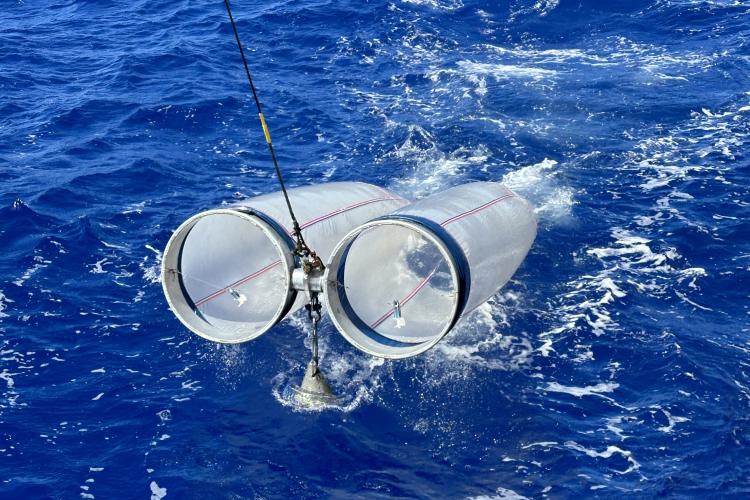
Bongo net during recovery. Credit: NOAA Fisheries/Emily Contreras
Instead of real-time depth monitoring, the bongo net relies more heavily on Temperature-Depth-Recorder devices that show us net depth after we retrieve it. Attached to the bottom of every net is a cod end, a cylindrical plastic container that holds the bulk of the collected sample. The bongo net filters water on its way down and on its way up—an oblique tow— catching everything between the surface and the target depth.
What does it capture?
The bongo net’s finer mesh typically captures small zooplankton, tiny (usually a few millimeters long) aquatic animals that drift with the currents, including:
- Copepods—Smallest of the ocean’s crustaceans, with an average body size of 1-2 millimeters, are important food sources for larval fish and other zooplankton
- Larval fish—Early stages of fish, hatching at just a few millimeters
- Cephalopod paralarvae—Early stage of squids and octopi
- Lobster larvae—around 8 millimeters in size
- Crab larvae
- Heteropods—Small molluscs with a transparent shell and body
- Gastropods—Sea snails
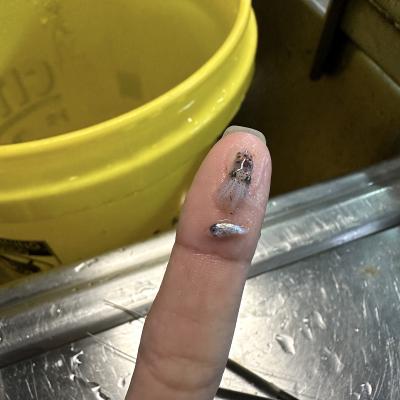 How do we process the sample? How do we process the sample?
We pour the contents of one cod end into progressively finer meshes (200–5,000 micrometers) to separate the plankton into different sizes. We then remove excess water and freeze the samples onto petri dishes. Once we’re back on land, we place the petri dishes in the oven at 30 degrees celsius for 24 hours before weighing to obtain dry mass.
Small cephalopod and larval fish caught in the bongo net. Credit: NOAA Fisheries/Emily Contreras -->
The other bongo cod end is split in half. One half is stored in 95 percent ethanol and the other half stored in formalin. Formalin is generally used for preserving the tissue structure of the organisms (important for visual identification) and ethanol preserves the genetic integrity of the sample (important for genetic identification). We can manually sort the samples later. It's crucial to properly label all samples; we typically use three levels of redundancy to ensure samples retain important information about when, where, and how they were collected. We use an interior label, an exterior label, and a handwritten label on the lid.
Isaacs-Kidd Midwater Trawl
The Isaacs-Kidd midwater trawl consists of a large metal paravane and spreader bar attached to a 505 micrometer mesh net. The paravane used during the Bigeye Oceanography research mission measured 6 feet across and is made out of stainless steel. The Isaacs-Kidd midwater trawl does not need a weight because it uses the force of the water acting on the wing shaped paravane frame to guide it into the ocean. Once in the water, we create a “yo-yo” effect with the net, essentially repeatedly lowering the net to 50 meters and bringing it back to the surface three times. This type of “yo-yo” towing helps capture plankton that can swim away and avoid the net. It is also better at covering the patchy distribution of open ocean plankton throughout the water column. This is similar to an oblique tow, but is just repeated multiple times during a single tow.
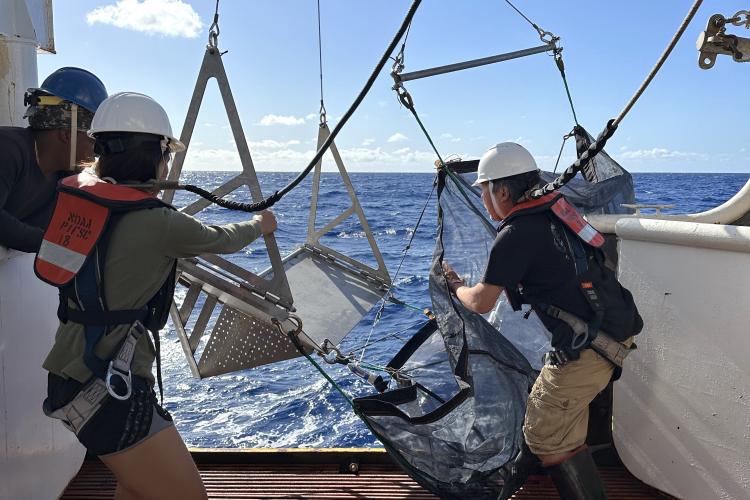
Deployment of the Isaacs-Kidd midwater trawl. Credit: NOAA Fisheries/Emily Contreras
What does it capture?
The Isaacs-Kidd midwater trawl typically captures slightly larger and more active zooplankton in the water column than those captured in the bongo plankton net.
How do we process the sample?
We strain the collected sample through a 505 micron filter and place the contents in 95 percent ethanol for preservation
Tucker Trawl
The Tucker trawl has a 10 foot wide mouth with two large metal bars, one at the top of the net and the other at the bottom to stabilize it underwater. The bar at the bottom is filled with lead weights, weighing about 400 pounds, to help the net reach its target depths. It has a primary net with a mesh size of about .25 inch that is attached to a ring net with a mesh size of 1,000 micrometers. The Tucker trawl uses an oblique tow at a 45 degree angle and a target depth of 550 meters. A Conductivity, Temperature, Depth (CTD) device or other net mensuration system is attached to it. This allows us to monitor net depth in real time and adjust the amount of wire accordingly.

Deployment of the Tucker trawl. Credit: NOAA Fisheries
What does it capture?
The Tucker trawl captures larger micronekton, actively swimming organisms ranging in size from 2 to 20 cm. Examples of micronekton include:
- Angler fish—Deep-sea fish with a modified luminescent lure to attract prey
- Leptocephalus—Larval eels
- Hatchetfish—Family of small, silver, deep-sea fish
- Shrimps—Some species shoot out bioluminescence when spooked
- Dragonfish—Family of deep-sea fish with large, fang-like teeth
- Salps—Gelatinous, transparent zooplankton with a barrel-shaped body that moves by contracting
How do we process the sample?
We empty the contents from the cod end onto a tray and sort by organism type: large fish, cephalopods, crustaceans, gelatinous organisms, and miscellaneous zooplankton. We weigh these groups and preserve them in 95 percent ethanol. The Tucker trawl provides a great opportunity to preserve voucher specimens for poorly studied taxa. The samples are photographed, given a tentative identification, and later sent to the Smithsonian National Museum of Natural History to fill gaps in genetic databases.
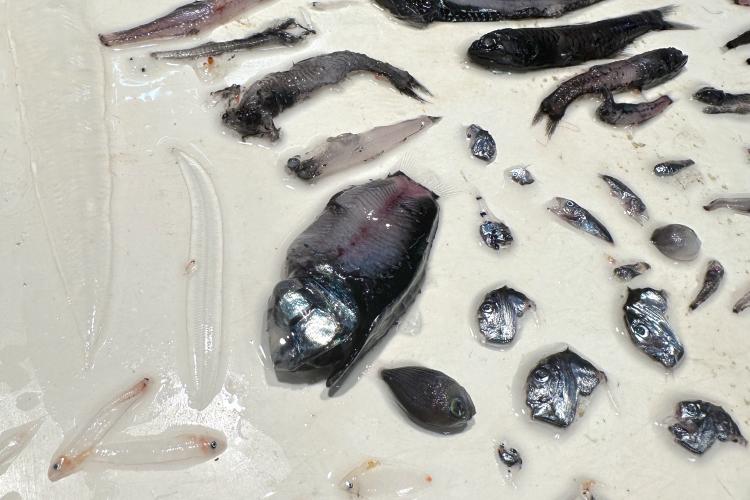
Variety of midwater fish caught in the Tucker trawl. Credit: NOAA Fisheries/Emily Contreras
Large Nets Support Large Missions
These nets contributed greatly to our Bigeye Tuna Oceanography research mission to sample the ecosystem structure of open ocean eddies in the central North Pacific Ocean. Because eddies may be important feeding grounds for large predators like tuna, it is important to understand what these prey communities look like and how they might change over time. These large nets helped us gather the small zooplankton and larger micronekton that make up this ecosystem. Collecting this important scientific information can also support management of bigeye tuna and other commercially important species in these habitats.
Source: NOAA Fisheries
[email protected]
www.seafood.media
|



